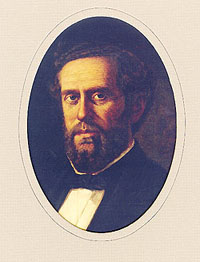- John Ireland (politician)
Infobox Governor
honorific-prefix =
name =John Ireland
honorific-suffix =
order =18th
office =Governor of Texas
term_start =1883
term_end =1887
lieutenant =
predecessor =Oran M. Roberts
successor =Lawrence Sullivan Ross John Ireland (
January 21 ,1827 ndashMarch 15 ,1896 ) was the 18th Governor of Texas from 1883 to 1887. During Ireland's term, the University of Texas was established, and construction on theTexas State Capitol began. Ireland is credited with the selection of local pinkgranite as the construction material.Early years
Ireland was born
June 1 ,1826 inHart County, Kentucky to Irish immigrants Patrick and Rachel (Newton) Ireland.citation|last=Elliott|first=Claude|title=John Ireland|publisher=Handbook of Texas |url=http://www.tsha.utexas.edu/handbook/online/articles/II/fir1.html|accessdate=2007-09-25] Although he had little formal education, when he was 18 he was appointed deputy sheriff of the county. He went on to study law and was admitted to the bar.Hendrickson (1995), p. 109.]In 1852, Ireland moved to
Texas , where he settled in Seguin and practiced law. Two years later, he married Mathilda Wicks Faircloth. She died in 1856, and the following year Ireland married Anna Maria Penn. They had three children together.Ireland was elected the mayor of Seguin in 1858. A firm believer in states' rights, Ireland was an ardent secessionist and served as a delegate to the 1861 Secession Convention. He joined the
Confederate States Army as a private and was eventually promoted to colonel. Throughout the Civil War, Ireland served within the Texas borders, patrolling along theRio Grande border and along theGulf Coast .Following the war, Ireland participated in the Reconstruction Convention of 1866 and was soon elected judge of the Seguin District. He was removed from his position the following year when Radical Republicans seized power.
tate politics
Ireland reentered politics in 1872, when he was elected to the
Texas House of Representatives and chaired the executive committee of the Democratic party. In 1875, he served as an associate justice on theTexas Supreme Court . Later that year, he was a delegate to the Constitutional Convention.Hendrickson (1995), p. 111.] The new state constitution reduced the number of associate justices on the supreme court, and in 1876 Ireland lost his position.In late 1875, Ireland decided to run for the
U.S. Senate . His primary competition was the currentGovernor of Texas ,Richard Coke . Coke's supporters accused Ireland of having been a member of theKnow-Nothing party and of opposing ratification of the new constitution. Ireland lost the election and remained in the Texas House.During his time as a state legislator, Ireland backed the bill creating the
University of Texas at Austin . He was also a proponent of low taxes and favored regulating the railroads. In 1882, GovernorOran Roberts declined to run again, and Ireland received the Democratic nomination. His main competition was G. "Wash" Jones of theGreenback party. Ireland defeated Jones by over 48,000 votes.Hendrickson (1995), p. 112.] One of his first acts as governor was to have an amendment added to the state constitution establishing anad valorem tax . He also reformulated the policy for selling public lands. While "this policy at first increased the state's revenues... [it] eventually led to large accumulations of land in the form of cattle ranches." The ranchers soon began runningbarbed wire around their own land and the public lands that they used, without permission, for grazing. This practice often cut farmers and other ranchers off from water. During a large drought in 1882, people began cutting the barbed wire, leading to violence between the ranchers and farmers. Ireland called a special session of the legislature in 1884 to pass a law allowing the Texas Rangers to intervene in these disputes. The Rangers were able to quell some, but not all, of the violence.Construction began on the new
Texas State Capitol building during Ireland's tenure. At his insistence, the building was constructed of Texas pink granite instead of imported Indiana limestone.Later years
After completing his second term in office, Ireland again ran for a US Senate seat and again lost. He returned to Seguin to practice law. His profits were invested in land and railroad stocks. During the
panic of 1893 , Ireland lost everything. He died onMarch 15 ,1896 .Notes
References
*citation|last=Hendrickson|first=Kenneth E., Jr.|title=The Chief of Executives of Texas: From Stephen F. Austin to John B. Connally, Jr.|publisher=
Texas A&M University Press |location=College Station, Texas |date=1995|isbn=0890966419External links
* [http://texashistory.unt.edu/permalink/meta-pth-5827:266 Entry for John Ireland] from the [http://texashistory.unt.edu/permalink/meta-pth-5827 "Biographical Encyclopedia of Texas"] published 1880, hosted by the [http://texashistory.unt.edu/ Portal to Texas History.]
Wikimedia Foundation. 2010.
